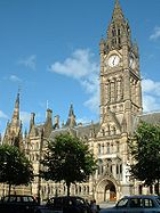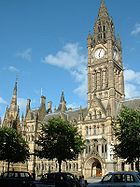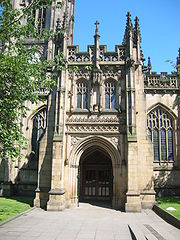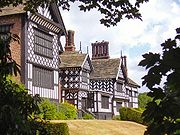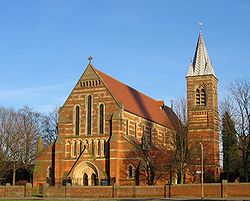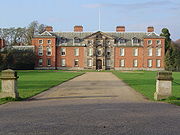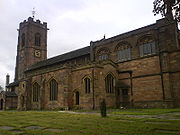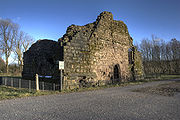| There are 48 Grade I listed buildings in Greater Manchester, England. In the United Kingdom, the term listed building refers to a building or other structure officially designated as being of special architectural, historical or cultural significance; Grade I structures are those considered to be "buildings of exceptional interest". In England, the authority for listing under the Planning (Listed Buildings and Conservation Areas) Act 1990 The Planning Act 1990 is an Act of Parliament of the United Kingdom that altered the laws on granting of planning permission for building works, notably including those of the listed building system in England and Wales....
rests with English HeritageEnglish Heritage . is an executive non-departmental public body of the British Government sponsored by the Department for Culture, Media and Sport...
, a non-departmental public bodyIn the United Kingdom, a non-departmental public body —often referred to as a quango—is a classification applied by the Cabinet Office, Treasury, Scottish Government and Northern Ireland Executive to certain types of public bodies...
sponsored by the Department for Culture, Media and SportThe Department for Culture, Media and Sport is a department of the United Kingdom government, with responsibility for culture and sport in England, and some aspects of the media throughout the whole UK, such as broadcasting and internet....
.
The metropolitan countyThe metropolitan counties are a type of county-level administrative division of England. There are six metropolitan counties, which each cover large urban areas, typically with populations of 1.2 to 2.8 million...
of Greater ManchesterGreater Manchester is a metropolitan county in North West England, with a population of 2.6 million. It encompasses one of the largest metropolitan areas in the United Kingdom and comprises ten metropolitan boroughs: Bolton, Bury, Oldham, Rochdale, Stockport, Tameside, Trafford, Wigan, and the...
is made up of 10 metropolitan boroughA metropolitan borough is a type of local government district in England, and is a subdivision of a metropolitan county. Created in 1974 by the Local Government Act 1972, metropolitan boroughs are defined in English law as metropolitan districts, however all of them have been granted or regranted...
s: BoltonThe Metropolitan Borough of Bolton is a metropolitan borough of Greater Manchester, England. It is named after its largest settlement, Bolton, but covers a far larger area which includes Blackrod, Farnworth, Horwich, Kearsley and Westhoughton, and a suburban and rural element from the West Pennine...
, BuryThe Metropolitan Borough of Bury is a metropolitan borough of Greater Manchester, in North West England. Lying to the north of the City of Manchester, the borough is composed of six towns: Bury, Ramsbottom, Tottington, Radcliffe, Whitefield and Prestwich, and has a population of 181,900...
, Manchester, OldhamThe Metropolitan Borough of Oldham is a metropolitan borough of Greater Manchester, England. It has a population of 219,600, and spans . The borough is named after its largest town, Oldham, but also includes the outlying towns of Chadderton, Failsworth, Royton and Shaw and Crompton, the village of...
, RochdaleThe Metropolitan Borough of Rochdale is a metropolitan borough of Greater Manchester in North West England. It is named after its largest town, Rochdale, but spans a far larger area which includes the towns of Middleton, Heywood, Littleborough and Milnrow, and the village of Wardle.The borough was...
, SalfordThe City of Salford is a city and metropolitan borough of Greater Manchester, England. It is named after its largest settlement, Salford, but covers a far larger area which includes the towns of Eccles, Swinton-Pendlebury, Walkden and Irlam which apart from Irlam each have a population of over...
, StockportThe Metropolitan Borough of Stockport is a metropolitan borough of Greater Manchester, in north west England, centred around the town of Stockport. It has a population of about 280,600 and includes the outyling areas of Cheadle and Cheadle Hulme, Marple, Bredbury, Reddish and Romiley...
, Tameside, Trafford and WiganThe Metropolitan Borough of Wigan is a metropolitan borough of Greater Manchester, in North West England. It is named after its largest component town, Wigan and also includes the towns of Leigh, Ashton-in-Makerfield, Ince-in-Makerfield, and Hindley. The borough was formed in 1974 and is an...
. The Grade I buildings in each borough are listed separately. Manchester, the world's first industrialised city, has 15 of Greater Manchester's 47 Grade I listed buildings, the highest number of any borough. OldhamOldham is a large town in Greater Manchester, England. It lies amid the Pennines on elevated ground between the rivers Irk and Medlock, south-southeast of Rochdale, and northeast of the city of Manchester...
is the only borough to have no listed buildings with a Grade I rating. The River IrwellThe River Irwell is a long river which flows through the Irwell Valley in the counties of Lancashire and Greater Manchester in North West England. The river's source is at Irwell Springs on Deerplay Moor, approximately north of Bacup, in the parish of Cliviger, Lancashire...
forms the boundary between Manchester and Salford, so one listed structure, the railway bridge over the Irwell, has been listed under both Manchester and Salford.
Most of Greater Manchester's listed buildings date from the VictorianThe term Victorian architecture refers collectively to several architectural styles employed predominantly during the middle and late 19th century. The period that it indicates may slightly overlap the actual reign, 20 June 1837 – 22 January 1901, of Queen Victoria. This represents the British and...
and EdwardianEdwardian architecture is the style popular when King Edward VII of the United Kingdom was in power; he reigned from 1901 to 1910, but the architecture style is generally considered to be indicative of the years 1901 to 1914....
periods. According to an Association for Industrial ArchaeologyThe Association for Industrial Archaeology, or AIA, is a body promoting the research, recording, preservation and presentation of the Industrial Heritage of the United Kingdom...
publication, Greater Manchester is "one of the classic areas of industrial and urban growth in Britain, the result of a combination of forces that came together in the 18th and 19th centuries: a phenomenal rise in population, the appearance of the specialist industrial town, a transport revolution, and weak local lordship". Much of the region, historically a part of LancashireLancashire is a non-metropolitan county of historic origin in the North West of England. It takes its name from the city of Lancaster, and is sometimes known as the County of Lancaster. Although Lancaster is still considered to be the county town, Lancashire County Council is based in Preston...
, was at the forefront of textile manufacturingThe industrial revolution changed the nature of work and society. Opinion varies as to the exact date, but it is estimated that the First Industrial Revolution took place between 1750 and 1850, and the second phase or Second Industrial Revolution between 1860 and 1900. The three key drivers in...
from the early 19th century until the early 20th century, and the county includes several former mill townA mill town, also known as factory town or mill village, is typically a settlement that developed around one or more mills or factories .- United Kingdom:...
s. Greater Manchester has a wealth of industrial heritageIndustrial heritage is an aspect of cultural heritage dealing specifically with the buildings and artifacts of industry which are inherited from past generations, maintained in the present and bestowed for the benefit of future generations, often forming a significant attraction for tourism.The...
, represented by industrial architecture found throughout the county, but most of its Grade I listed buildings have a municipalA municipality is essentially an urban administrative division having corporate status and usually powers of self-government. It can also be used to mean the governing body of a municipality. A municipality is a general-purpose administrative subdivision, as opposed to a special-purpose district...
, ecclesiastic or other cultural heritageCultural heritage is the legacy of physical artifacts and intangible attributes of a group or society that are inherited from past generations, maintained in the present and bestowed for the benefit of future generations...
.
The oldest Grade I listed structure in Greater Manchester is the Parish Church of St Mary the VirginThe Church of St Mary the Virgin is a church in Eccles, Greater Manchester, England.Historically within Lancashire it was built in the 13th century and was designated a Grade II* listed building by English Heritage in 1964...
in EcclesEccles is a town in the City of Salford, a metropolitan borough of Greater Manchester in North West England, west of Salford and west of Manchester city centre...
, completed in the 13th century but greatly expanded since then. There are eight listed manor houseA manor house is a country house that historically formed the administrative centre of a manor, the lowest unit of territorial organisation in the feudal system in Europe. The term is applied to country houses that belonged to the gentry and other grand stately homes...
s, the earliest of which date from the 14th century; Wardley HallWardley Hall is an early medieval manor house and a Grade I listed building in the Wardley area of Worsley, in Greater Manchester . . There has been a moat on the site since at least 1292. The current hall dates from around 1500 but was extensively rebuilt in the 19th and 20th centuries. The 1894...
, still in use today as the residence of the Roman Catholic Bishop of SalfordThe Bishop of Salford is the Ordinary of the Roman Catholic Diocese of Salford in the Province of Liverpool, England.With the gradual abolition of the legal restrictions on the activities of Catholics in England and Wales in the early 19th century, Rome decided to proceed to bridge the gap of the...
, has the preserved skull of St Ambrose BarlowAmbrose Edward Barlow, O.S.B., was an English Benedictine monk who is venerated as a saint in the Catholic Church. He is one of a group of saints canonized by Pope Paul VI who became known as the Forty Martyrs of England and Wales....
– one of the Forty Martyrs of England and WalesThe Forty Martyrs of England and Wales are a group of men and women who were executed for treason and related offences in the Kingdom of England between 1535 and 1679...
– on display in a niche at the top of the main staircase. Three buildings are attributed to engineer George StephensonGeorge Stephenson was an English civil engineer and mechanical engineer who built the first public railway line in the world to use steam locomotives...
. One of them, Liverpool Road railway stationManchester Liverpool Road is a former railway station on the Liverpool and Manchester Railway in Manchester, England which opened on 15 September 1830. The L&MR station was the terminus of the world's first inter-city passenger railway in which all services were hauled by timetabled steam locomotives...
, is the oldest surviving railway station in the world. The newest Grade I listed building in Greater Manchester is Royd HouseRoyd House is a Grade I listed building in Hale, Greater Manchester. It was designed by architect Edgar Wood as his own home and was built between 1914 and 1916. The building is regarded as one of the most advanced examples of early twentieth century domestic architecture...
, built and designed by Edgar WoodEdgar Wood was an architect who practised from Manchester at the turn of the 20th century and gained a considerable reputation both in Britain and abroad, notably in Germany. British design was then of European significance. His work is principally domestic, but he designed several churches and...
in 1916 as his residence. Twenty-two buildings, almost half of the total, were completed in the .
Bolton
| Name |
Completed |
Architect |
Location |
Grid Ref •
• |
Ref(s) |
10 Firwood Fold10 Firwood Fold is a 16th century house in Bolton, Greater Manchester . It is a Grade I listed building and the birthplace of Samuel Crompton....
|
16th century |
|
Firwood Fold, BoltonBolton is a town in Greater Manchester, in the North West of England. Close to the West Pennine Moors, it is north west of the city of Manchester. Bolton is surrounded by several smaller towns and villages which together form the Metropolitan Borough of Bolton, of which Bolton is the...
|
|
|
| Church of the Holy Trinity |
1825 The year 1825 in architecture involved some significant events.-Buildings:* The front and rear porticoes of The White House are added to the building.* Tuskulėnai Manor in Vilnius by Karol Podczaszyński completed-Births:...
|
Philip Hardwick Philip Hardwick was an eminent English architect, particularly associated with railway stations and warehouses in London and elsewhere...
|
Trinity Street, Bolton |
|
|
Hall i' th' WoodHall i' th' Wood is an early 16th century manor house in Bolton, Greater Manchester . It is a Grade I listed building and is currently used as a museum by Bolton Metropolitan Borough Council. The original building is timber framed and has a stone flagged roof; there were later additions to the...
|
16th century |
|
Hall i' th' Wood Lane, Bolton |
|
|
| Parish Church of St Peter |
1871 The year 1871 in architecture involved some significant events.-Buildings:* March 29 - The Royal Albert Hall in London designed by Francis Fowke and H. Y...
|
Edward Graham Paley Edward Graham Paley, usually known as E. G. Paley, , was an English architect who practised in Lancaster, Lancashire, in the second half of the 19th century.-Education and career:...
|
Churchgate, Bolton |
|
|
| Smithills Hall Smithills Hall is a Grade I listed manor house, and a Scheduled Monument in the township of Halliwell, now in Bolton, Greater Manchester, England. it stands on the slopes of the moors above Bolton at a height of 500 feet, two miles north west of the town centre. It occupies a defensive site near...
|
14th century |
|
Smithills Dean Road, Bolton |
|
|
Bury
| Name |
Completed |
Architect |
Location |
Grid Ref |
Ref(s) |
Church of All SaintsAll Saints' Church is a Grade I listed building located on Church Lane in Stand, Whitefield, Greater Manchester, England. It is an active Church of England parish church in the Diocese of Manchester.-History:...
|
1826 The year 1826 in architecture involved some significant events.-Buildings:* The Menai Suspension Bridge over the Menai Strait in Wales, designed by Thomas Telford is completed.* The Bank of England in London, designed by Sir John Soane, is completed....
|
Charles Barry Sir Charles Barry FRS was an English architect, best known for his role in the rebuilding of the Palace of Westminster in London during the mid-19th century, but also responsible for numerous other buildings and gardens.- Background and training :Born on 23 May 1795 in Bridge Street, Westminster...
|
Church Lane, WhitefieldWhitefield is a town within the Metropolitan Borough of Bury, in Greater Manchester, England. It lies on undulating ground in the Irwell Valley, along the south bank of the River Irwell, south-southeast of Bury, and to the north-northwest of the city of Manchester...
|
|
|
| Church of St Mary and St Bartholomew |
14th century |
|
Church Green, RadcliffeRadcliffe is a town within the Metropolitan Borough of Bury, in Greater Manchester, England. It lies on undulating ground in the Irwell Valley, along the course of the River Irwell, south-west of Bury and north-northwest of Manchester. Radcliffe is contiguous with the town of Whitefield to the...
|
|
|
| Parish Church of St Mary the Virgin The Church of St Mary the Virgin, Prestwich, is located in Church Lane, Prestwich, Greater Manchester, England. It is an active Anglican parish church in the deanery of Radcliffe and Prestwich, the archdeaconry of Bolton, and the diocese of Manchester. The church has been designated by English...
|
15th century |
|
Church Lane, PrestwichPrestwich is a town within the Metropolitan Borough of Bury, in Greater Manchester, England. It lies close to the River Irwell, north of Manchester city centre, north of Salford and south of Bury....
|
|
|
| Parish Church of St Mary the Virgin The Parish Church of St Mary the Virgin is a Grade I listed building in Bury, Greater Manchester, England.- History :Church records suggest that the first church was built on the site in 971 when parishes were first formed by King Edgar of England, although this is likely to have been a wood and...
|
1876 The year 1876 in architecture involved some significant events.-Buildings:* The Bayreuth Festspielhaus, designed by Gottfried Semper, is completed.* Government House, Melbourne, Australia, designed by William Wardell is completed....
|
J. S. Crowther |
Market Place, BuryBury is a town in Greater Manchester, England. It lies on the River Irwell, east of Bolton, west-southwest of Rochdale, and north-northwest of the city of Manchester...
|
|
|
Radcliffe TowerRadcliffe Tower is the only surviving part of a manor house in Radcliffe, Greater Manchester . It is a Grade I listed building and a Scheduled Monument. The house was rebuilt in 1403 by James de Radcliffe, who was lord of the manor of Radcliffe, and consisted of a stone-built hall and one or two...
|
1403 -Buildings:* 1402 - Seville Cathedral is begun.* 1403** The Gur-e Amir Mausoleum is built in Samarkand by Timur.** The Temple of a City God is built in Shanghai.* 1405 - The Changdeokgung of Korea is completed.* 1409...
|
|
Church Street East, RadcliffeRadcliffe is a town within the Metropolitan Borough of Bury, in Greater Manchester, England. It lies on undulating ground in the Irwell Valley, along the course of the River Irwell, south-west of Bury and north-northwest of Manchester. Radcliffe is contiguous with the town of Whitefield to the...
|
|
|
Manchester
| Name |
Completed |
Architect |
Location |
Grid Ref |
Ref(s) |
| Albert Memorial Albert Square is a public square in the centre of Manchester, England.It is dominated by its largest building, Manchester Town Hall , a Victorian Gothic building by Alfred Waterhouse...
|
1867 The year 1867 in architecture involved some significant events.-Buildings:* January 1 — The John A. Roebling Suspension Bridge in Cincinnati, Ohio and Covington, Kentucky is formally opened....
|
Thomas Worthington Thomas Worthington was a 19th-century English architect, particularly associated with public buildings in and around Manchester.-Early life:...
|
Albert Square Albert Square is a public square in the centre of Manchester, England.It is dominated by its largest building, Manchester Town Hall , a Victorian Gothic building by Alfred Waterhouse...
|
|
|
Baguley HallBaguley Hall is a 14th century timber framed hall in Baguley, Greater Manchester . It is listed as a Grade I listed building and a Scheduled Ancient Monument....
|
14th century |
|
Hall Lane, BaguleyBaguley is a locality in Wythenshawe, and an electoral ward of the city of Manchester in North West England.Historically within Cheshire, the town is mentioned as Bagelei in the Domesday Book of 1086.-History:...
|
|
|
| Chetham's Library Chetham's Library in Manchester, England is the oldest free public reference library in the United Kingdom. Chetham's Hospital, which contains both the library and Chetham's School of Music, was established in 1653 under the will of Humphrey Chetham , for the education of "the sons of honest,...
|
1422 -Buildings:* 1419 - 1424 - Spedale degli Innocenti in Florence designed by Filippo Brunelleschi.* 1420 - Ca' d'Oro, Venice, built for doge Mariano Contarini.* 1420 - Khan Jaqmaq, Damascus is completed.* 1420 - Forbidden City of Beijing, China is completed...
|
|
Long Millgate, City Centre |
|
|
Church of the Holy Name of JesusThe Church of the Holy Name of Jesus is located on Oxford Road in the heart of Manchester University's campus in Manchester, England and next door to the University hospitals. It was built between 1869 and 1871 and designed by Joseph A. Hansom & Son. The present tower, designed by Gilbert Scott,...
|
1871 The year 1871 in architecture involved some significant events.-Buildings:* March 29 - The Royal Albert Hall in London designed by Francis Fowke and H. Y...
|
Joseph HansomJoseph Aloysius Hansom was a prolific English architect working principally in the Gothic Revival style, who invented the Hansom cab and was one of the founders of the eminent architectural journal, The Builder, in 1843....
|
Oxford Road Wilmslow Road is a major thoroughfare in Manchester, England, running from Parrs Wood north into Manchester City Centre. Its name changes to Oxford Road at Whitworth Park, north of Rusholme, and changes again to Oxford Street, when it reaches the city centre.The road runs through the centres of...
, Chorlton-on-MedlockChorlton-on-Medlock is an inner city area of Manchester, England.Historically a part of Lancashire, the northern border of Chorlton-on-Medlock is the River Medlock which runs immediately south of Manchester city centre. Its other borders roughly correspond to Stockport Road, Hathersage Road, Moss...
|
|
|
Church of St AnnSt Ann's Church, Manchester, was consecrated in 1712. Although named after St Anne, it also pays tribute to the patron of the church, Ann, Lady Bland. St Ann's Church is a Grade I listed building.-Architecture and setting:...
|
1712 The year 1712 in architecture involved some significant events.-Buildings:* Castle Howard , designed by Sir John Vanbrugh and Nicholas Hawksmoor, is completed.* Roehampton House in England, designed by Thomas Archer is completed....
|
Christopher WrenSir Christopher Wren FRS is one of the most highly acclaimed English architects in history.He used to be accorded responsibility for rebuilding 51 churches in the City of London after the Great Fire in 1666, including his masterpiece, St. Paul's Cathedral, on Ludgate Hill, completed in 1710...
(by tradition) |
St Ann's Square |
|
|
| Edgar Wood Centre The Edgar Wood Centre is a former Church of Christ, Scientist building in Fallowfield, Manchester, England. Pevsner considered it "the only religious building in Lancashire that would be indispensable in a survey of twentieth century church design in all England." It is a Grade I listed...
|
1903 The year 1903 in architecture involved some significant events.-Buildings:* The Amsterdam Stock Exchange designed by Hendrik Berlage is opened.* Giles Gilbert Scott wins the competition to design Liverpool Cathedral....
|
Edgar WoodEdgar Wood was an architect who practised from Manchester at the turn of the 20th century and gained a considerable reputation both in Britain and abroad, notably in Germany. British design was then of European significance. His work is principally domestic, but he designed several churches and...
|
Daisy Bank Road, Rusholme-Etymology:Rusholme, unlike other areas of Manchester which have '-holme' in the place name is not a true '-holme'. Its name came from ryscum, which is the dative plural of Old English rysc "rush": "[at the] rushes"...
|
|
|
Former Bank of EnglandThe Former Bank of England building on King Street, Manchester is a historic banking building. It has been recognised as a Grade I listed building, maintained by Manchester City Council...
|
1846 The year 1846 in architecture involved some significant events.-Buildings:* Trinity Church in New York City, New York, United States is completed and consecrated....
|
Charles Robert Cockerell Charles Robert Cockerell was an English architect, archaeologist, and writer.-Life:Charles Robert Cockerell was educated at Westminster School from 1802. From the age of sixteen, he trained in the architectural practice of his father, Samuel Pepys Cockerell...
|
King Street King Street is one of the most important thoroughfares of the city of Manchester, England. Once the centre of the north-west banking industry it is now predominantly an affluent shopping area.-History:...
, Deansgate |
|
|
| Heaton Hall |
1789 The year 1789 in architecture involved some significant events.-Buildings:* The Panthéon, Paris, designed by Jacques-Germain Soufflot was completed.* In Rhode Island, the First Methodist Church is built, with a 160-foot spire....
|
James WyattJames Wyatt RA , was an English architect, a rival of Robert Adam in the neoclassical style, who far outdid Adam in his work in the neo-Gothic style.-Early classical career:...
|
Heaton ParkHeaton Park, covering an area variously reported as , 247 hectares, , over and is the biggest park in Greater Manchester, England and one of the biggest municipal parks in Europe. The park comprises the grounds of a Grade I listed, neoclassical 18th century country house, Heaton Hall...
, Greater Manchester |
|
|
John Rylands LibraryThe John Rylands Library is a Victorian Gothic building on Deansgate in Manchester, England. The library, which opened to the public in 1900, was founded by Mrs Enriqueta Augustina Rylands in memory of her late husband, John Rylands...
|
1899The year 1899 in architecture involved some significant events.-Buildings:* Maison du Peuple in Brussels, designed by Victor Horta is completed ....
|
Basil ChampneysBasil Champneys was an architect and author whose more notable buildings include Newnham College, Cambridge, Manchester's John Rylands Library, Mansfield College, Oxford and Oriel College, Oxford's Rhodes Building.- Life :...
|
DeansgateDeansgate is a main road through the city centre of Manchester, England. It runs roughly north–south in a near straight route through the western part of the city centre and is the longest road in the city centre at over one mile long....
|
|
|
| Liverpool Road railway station Manchester Liverpool Road is a former railway station on the Liverpool and Manchester Railway in Manchester, England which opened on 15 September 1830. The L&MR station was the terminus of the world's first inter-city passenger railway in which all services were hauled by timetabled steam locomotives...
|
1830The year 1830 in architecture involved some significant events.-Buildings:* The Altes Museum in Berlin, designed by Karl Friedrich Schinkel, which was begun in 1823, is completed.-Births:* January 27 - Edward Middleton Barry...
|
George StephensonGeorge Stephenson was an English civil engineer and mechanical engineer who built the first public railway line in the world to use steam locomotives...
|
Liverpool Road, City centre |
|
|
| Manchester Art Gallery Manchester Art Gallery is a publicly-owned art gallery in Manchester, England. It was formerly known as Manchester City Art Gallery.The gallery was opened in 1824 and today occupies three buildings, the oldest of which - designed by Sir Charles Barry - is Grade I listed and was originally home to...
|
1835 The year 1835 in architecture involved some significant events.-Buildings:* The redesign of Buckingham Palace by John Nash is completed.* Robert Mills starts to build Old Patent Office Building, Washington D.C., USA....
|
Charles Barry Sir Charles Barry FRS was an English architect, best known for his role in the rebuilding of the Palace of Westminster in London during the mid-19th century, but also responsible for numerous other buildings and gardens.- Background and training :Born on 23 May 1795 in Bridge Street, Westminster...
|
Mosley Street, City centre |
|
|
Manchester CathedralManchester Cathedral is a medieval church on Victoria Street in central Manchester and is the seat of the Bishop of Manchester. The cathedral's official name is The Cathedral and Collegiate Church of St Mary, St Denys and St George in Manchester...
|
1421 -Buildings:* 1419 - 1424 - Spedale degli Innocenti in Florence designed by Filippo Brunelleschi.* 1420 - Ca' d'Oro, Venice, built for doge Mariano Contarini.* 1420 - Khan Jaqmaq, Damascus is completed.* 1420 - Forbidden City of Beijing, China is completed...
|
|
Fennel Street, City centre |
|
|
Manchester Town HallManchester Town Hall is a Victorian-era, Neo-gothic municipal building in Manchester, England. The building functions as the ceremonial headquarters of Manchester City Council and houses a number of local government departments....
|
1877 The year 1877 in architecture involved some significant events.-Buildings:* Galleria Vittorio Emanuele in Milan, designed by Giuseppe Mengoni is completed.* Manchester Town Hall in Manchester, England is completed....
|
Alfred WaterhouseAlfred Waterhouse was a British architect, particularly associated with the Victorian Gothic Revival architecture. He is perhaps best known for his design for the Natural History Museum in London, and Manchester Town Hall, although he also built a wide variety of other buildings throughout the...
|
Albert Square |
|
|
| 1830 warehouse, Liverpool Road railway station The 1830 warehouse, Liverpool Road, Manchester, is a 19th-century warehouse that forms part of the Liverpool Road railway station complex. It was built in five months between April and September 1830, "almost certainly [to the designs of] the Liverpool architect Thomas Haigh". The British Listed...
|
c. 1830 |
Thomas Haigh |
Liverpool Road, City Centre |
|
|
| River Irwell Railway bridge The River Irwell Railway Bridge, also known as Prince's Bridge, Water Street, Manchester is a stone railway bridge of 1830 by George Stephenson. It forms part of Liverpool Road railway station, the world's first passenger railway line. The bridge was designated a Grade I listed building on 20...
|
1830The year 1830 in architecture involved some significant events.-Buildings:* The Altes Museum in Berlin, designed by Karl Friedrich Schinkel, which was begun in 1823, is completed.-Births:* January 27 - Edward Middleton Barry...
|
George StephensonGeorge Stephenson was an English civil engineer and mechanical engineer who built the first public railway line in the world to use steam locomotives...
|
Water Street, City centre |
|
|
Rochdale
| Name |
Completed |
Architect |
Location |
Grid Ref |
Ref(s) |
| Church of St Edmund St Edmund’s Church is a redundant church building located on Clement Royds Street in the Falinge area of Rochdale, in Greater Manchester, England...
|
1873 The year 1873 in architecture involved some significant events.-Buildings:* The Berlin victory column in Berlin, Germany is completed and inaugurated.* Midland Grand Hotel in London, United Kingdom is opened, the largest hotel in the world at the time....
|
J. M. and H. Taylor |
Edmund Street, RochdaleRochdale is a large market town in Greater Manchester, England. It lies amongst the foothills of the Pennines on the River Roch, north-northwest of Oldham, and north-northeast of the city of Manchester. Rochdale is surrounded by several smaller settlements which together form the Metropolitan...
|
|
|
Church of St LeonardSt Leonard's is an Anglican parish church in Middleton, Greater Manchester, England. It was designated a Grade I listed building by English Heritage in 1957....
|
1524 -Buildings:* c. 1520 – Lupert's Range , with Lupert's Tower, designed by architect Henry Redman, completed at Eton College* 1521 – Château de Chenonceau built in the French Loire Valley....
|
|
New Lane, MiddletonMiddleton is a town within the Metropolitan Borough of Rochdale, in Greater Manchester, England. It stands on the River Irk, south-southwest of Rochdale, and north-northeast of the city of Manchester...
|
|
|
| Rochdale Town Hall Rochdale Town Hall is a Victorian-era municipal building in Rochdale, Greater Manchester, England. It is "widely recognised as being one of the finest municipal buildings in the country", and is rated by English Heritage as a Grade I listed building...
|
1871 The year 1871 in architecture involved some significant events.-Buildings:* March 29 - The Royal Albert Hall in London designed by Francis Fowke and H. Y...
|
Alfred WaterhouseAlfred Waterhouse was a British architect, particularly associated with the Victorian Gothic Revival architecture. He is perhaps best known for his design for the Natural History Museum in London, and Manchester Town Hall, although he also built a wide variety of other buildings throughout the...
|
The Esplanade, RochdaleRochdale is a large market town in Greater Manchester, England. It lies amongst the foothills of the Pennines on the River Roch, north-northwest of Oldham, and north-northeast of the city of Manchester. Rochdale is surrounded by several smaller settlements which together form the Metropolitan...
|
|
|
Salford
| Name |
Completed |
Architect |
Location |
Grid Ref |
Ref(s) |
Church of St AugustineSt. Augustine's is a High Anglican church in the Diocese of Manchester, once called "The Miners' Cathedral" due to its almost "cathedralesque" stature in the heart of a one time coal mining community. Also sometimes called "Gussie's" by locals....
|
1874 The year 1874 in architecture involved some significant events.-Buildings:* The Opéra Garnier, designed by Charles Garnier is completed.* California State Capitol in Sacramento, California is completed....
|
George Frederick Bodley George Frederick Bodley was an English architect working in the Gothic revival style.-Personal life:Bodley was the youngest son of William Hulme Bodley, M.D. of Edinburgh, physician at Hull Royal Infirmary, Kingston upon Hull, who in 1838 retired to his wife's home town, Brighton, Sussex, England....
|
Bolton Road, PendleburyPendlebury is a suburban town in the City of Salford, in Greater Manchester, England. It lies to the northwest of Manchester city centre, northwest of Salford, and southeast of Bolton....
|
|
|
Ordsall HallOrdsall Hall is a historic house and a former stately home in Ordsall, an area of Salford, in Greater Manchester, England. It dates back over 750 years, although the oldest surviving parts of the present hall were built in the 15th century. The most important period of Ordsall Hall's life was as...
|
c.16th century |
|
Taylorson Street, Salford |
|
|
Parish Church of St Mary the VirginThe Church of St Mary the Virgin is a church in Eccles, Greater Manchester, England.Historically within Lancashire it was built in the 13th century and was designated a Grade II* listed building by English Heritage in 1964...
|
13th century |
|
Church Street, Eccles Eccles is a town in the City of Salford, a metropolitan borough of Greater Manchester in North West England, west of Salford and west of Manchester city centre...
|
|
|
| River Irwell Railway bridge The River Irwell Railway Bridge, also known as Prince's Bridge, Water Street, Manchester is a stone railway bridge of 1830 by George Stephenson. It forms part of Liverpool Road railway station, the world's first passenger railway line. The bridge was designated a Grade I listed building on 20...
|
1830The year 1830 in architecture involved some significant events.-Buildings:* The Altes Museum in Berlin, designed by Karl Friedrich Schinkel, which was begun in 1823, is completed.-Births:* January 27 - Edward Middleton Barry...
|
George StephensonGeorge Stephenson was an English civil engineer and mechanical engineer who built the first public railway line in the world to use steam locomotives...
|
Water Street, City centre |
|
|
| St Mark's Church St Mark’s Church, Worsley, is an Anglican parish church in Salford, Greater Manchester, England. It is built on a prominent site formerly known as Cross Field and is a significant local landmark; it is now also a point of reference to the many who pass it on the M60 motorway, which bisects the...
|
1846 The year 1846 in architecture involved some significant events.-Buildings:* Trinity Church in New York City, New York, United States is completed and consecrated....
|
George Gilbert Scott Sir George Gilbert Scott was an English architect of the Victorian Age, chiefly associated with the design, building and renovation of churches, cathedrals and workhouses...
|
Worsley Brow, Worsley Worsley is a town in the metropolitan borough of the City of Salford, in Greater Manchester, England. It lies along the course of Worsley Brook, west of Manchester. The M60 motorway bisects the area....
|
|
|
Wardley HallWardley Hall is an early medieval manor house and a Grade I listed building in the Wardley area of Worsley, in Greater Manchester . . There has been a moat on the site since at least 1292. The current hall dates from around 1500 but was extensively rebuilt in the 19th and 20th centuries. The 1894...
|
c. 1500 |
|
Wardley Hall Road, Wardley Wardley is a district of Swinton near Manchester. It borders the Linnyshaw/Walkden and Swinton areas.-Road:The A6 road passes through the district with frequent bus services linking Bolton, Farnworth and Walkden with Swinton, Salford and Manchester...
|
|
|
Stockport
| Name |
Completed |
Architect |
Location |
Grid Ref |
Ref(s) |
Bramall HallBramall Hall is a Tudor manor house in Bramhall, within the Metropolitan Borough of Stockport, Greater Manchester, England. It is a timber-framed building, the oldest parts of which date from the 14th century, with later additions from the 16th and 19th centuries...
|
14th century |
|
BramhallBramhall is a suburb of the Metropolitan Borough of Stockport, in Greater Manchester, England. It has a population of about 25,500.Research by the University of Sheffield has placed Bramhall as the "least lonely" place in Britain. Bramhall is also regarded as an affluent area where most residents...
|
|
|
| St. Elisabeth's Church |
1883 The year 1883 in architecture involved some significant events.-Buildings:* The Home Insurance Building in Chicago designed by William LeBaron Jenney * The Kuhns Building in Dayton, Ohio, is constructed....
|
Alfred WaterhouseAlfred Waterhouse was a British architect, particularly associated with the Victorian Gothic Revival architecture. He is perhaps best known for his design for the Natural History Museum in London, and Manchester Town Hall, although he also built a wide variety of other buildings throughout the...
|
Leamington Road, Reddish Reddish is an area of the Metropolitan Borough of Stockport, in Greater Manchester, England. It is north of Stockport and southeast of Manchester...
|
|
|
Church of St GeorgeSt George's Church, Heaviley, is located in Buxton Road, Heaviley, an area of Stockport, Greater Manchester, England. It is an active Anglican parish church in the deanery of Stockport, the archdeaconry of Macclesfield, and the diocese of Chester. Its benefice is united with that of...
|
1897 The year 1897 in architecture involved some significant events.-Buildings:* May 1 - Tennessee Centennial Exposition opens in Nashville, with a temporary pyramid for Memphis, TN and a copy of the Parthenon, which will be rebuilt of permanent materials in the 1920s.* The Vienna Secession Building,...
|
Hubert Austin Hubert James Austin was an English architect who practiced in Lancaster. With his partners he designed many churches and other buildings, mainly in the northwest of England.-Early life and career:...
|
Buxton Road, Heaviley |
|
|
| Church of St Thomas -History:The church was designed by George Basevi in the neo-classical style. It was built as a Commissioners' church at a cost of £15,611 , and received a grant of £15,636 from the Church Building Commission to cover the cost of construction plus other expenses. The contractors were Samuel...
|
1822 The year 1822 in architecture involved some significant events.-Buildings:* St David's College in Lampeter, Wales, designed by Charles Cockerell, is completed.* Reconstruction of Chester Castle under Thomas Harrison is completed.-Births:...
|
George Basevi Elias George Basevi FRS was an English architect. He was the favourite pupil of Sir John Soane.-Life:Basevi was the youngest son of a City of London merchant, also named George Basevi...
|
St Thomas' Place, StockportStockport is a town in Greater Manchester, England. It lies on elevated ground southeast of Manchester city centre, at the point where the rivers Goyt and Tame join and create the River Mersey. Stockport is the largest settlement in the metropolitan borough of the same name...
|
|
|
St Mary's Parish ChurchSt Mary's Church, Stockport is the oldest parish church in the town of Stockport, Greater Manchester, England. It stands in Churchgate overlooking the market place . The church is a Grade I listed building...
|
1817 The year 1817 in architecture involved some significant events.-Buildings:* Dulwich Picture Gallery in London designed by Sir John Soane as the first purpose-built art gallery....
|
Lewis Wyatt Lewis William Wyatt was a British architect, a nephew of both Samuel and James Wyatt of the Wyatt family of architects, who articled with each of his uncles and began practice on his own about 1805....
|
Churchgate, StockportStockport is a town in Greater Manchester, England. It lies on elevated ground southeast of Manchester city centre, at the point where the rivers Goyt and Tame join and create the River Mersey. Stockport is the largest settlement in the metropolitan borough of the same name...
|
|
|
| St Mary's Church St Mary's Church, Cheadle, is in High Street, Cheadle, Greater Manchester, England. It has been designated by English Heritage as a Grade I listed building. It is an active Anglican parish church in the diocese of Chester, the archdeaconry of Macclesfield and the deanery of Cheadle...
|
1882The year 1882 in architecture involved some significant events.-Events:* September 30 – Dedication of Hearthstone House, in Appleton, Wisconsin, United States; the first residential building to be powered by a centrally located hydroelectric station using the Edison system.-Buildings:*...
|
|
High Street, Cheadle Cheadle is a suburb in the Metropolitan Borough of Stockport in Greater Manchester, England. It borders the districts of Cheadle Hulme, Gatley, Heald Green and Cheadle Heath in Stockport, and the East Didsbury area of Manchester. As of 2001 it had a population of 14,261.-Early history:There has...
|
|
|
Tameside
| Name |
Completed |
Architect |
Location |
Grid Ref |
Ref(s) |
| Church of St Anne St Anne's Church in Haughton, Denton is a Grade I Listed Building. The church was built in 1881 and designed by J. Medland Taylor. The construction was funded by E. Joseph Sidebotham, a member of the Sidebotham mill-owning family of Hyde...
|
1881 The year 1881 in architecture involved some significant events.-Buildings:*Alþingishúsið in Reykjavik, Iceland is opened to house the National Parliament*Natural History Museum in London, England is opened*Tweed Courthouse is completed in New York City...
|
J. Medland Taylor |
St Anne's Road, Denton Denton is a town within the Metropolitan Borough of Tameside, in Greater Manchester, England. It is five miles to the east of Manchester city centre, and has a population of 26,866....
|
|
|
Church of St Michael and All AngelsSt. Michael's Church in Ashton-under-Lyne is a Grade I Listed Building. It is one of 116 surviving medieval parish churches in the North West. The church dates back to at least 1262, and a church on the site was mentioned in the Domesday Book...
|
15th century |
|
Stamford Street, Ashton-under-Lyne Ashton-under-Lyne is a market town in the Metropolitan Borough of Tameside, Greater Manchester, England. Historically a part of Lancashire, it lies on the north bank of the River Tame, on undulating land at the foothills of the Pennines...
|
|
|
| Fairbottom Farm Barn |
17th century |
|
Alt Hill Lane, Ashton-under-Lyne Ashton-under-Lyne is a market town in the Metropolitan Borough of Tameside, Greater Manchester, England. Historically a part of Lancashire, it lies on the north bank of the River Tame, on undulating land at the foothills of the Pennines...
|
|
|
Trafford
| Name |
Completed |
Architect |
Location |
Grid Ref |
Ref(s) |
Church of All SaintsAll Saints' Church is a Roman Catholic church in Urmston, Greater Manchester, England, and is located on Redclyffe Road . The church was constructed between 1867 and 1868 and was designed by E. W. Pugin in the Gothic Revival style for Sir Humphrey de Trafford...
|
1868 The year 1868 in architecture involved some significant events.-Buildings:* Alfred Waterhouse wins the competition for the design of Manchester Town Hall in England.* The Gyeongbokgung of Korea is completed.-Awards:...
|
E. W. Pugin Edward Welby Pugin was the eldest son of Augustus Welby Northmore Pugin and Louisa Barton. His father, A. W. N. Pugin, was a famous architect and designer of Neo-Gothic architecture, and after his death in 1852 Edward took up his successful practice...
|
Redclyffe Road, UrmstonUrmston is a town within the Metropolitan Borough of Trafford, in Greater Manchester, England, with a population of around 41,000. Historically a part of Lancashire, it lies about six miles to the southwest of Manchester city centre. The southern boundary is marked by the River Mersey and the...
|
|
|
| Dunham Massey Hall |
1616 -Buildings:* 1610 - The Changdeokgung of Korea is reconstructed.* 1610 - The Church of San Giorgio Maggiore in Venice, Italy, designed by Palladio is completed* 1611 - The Catholic church of Virgen del Rosario is built in Benejúzar, Spain....
|
|
Dunham MasseyDunham Massey is a civil parish in the Metropolitan Borough of Trafford, Greater Manchester, England. The parish includes the villages of Sinderland Green, Dunham Woodhouse and Dunham Town, along with Dunham Massey Park, formerly the home of the last Earl of Stamford and owned by the National Trust...
|
|
|
| Dunham Massey carriage house |
1721 The year 1721 in architecture involved some significant events....
|
|
Dunham Massey |
|
|
| Dunham Massey stables |
1721 The year 1721 in architecture involved some significant events....
|
|
Dunham Massey |
|
|
Old Church of St WerburghSt Werburgh's Church, Warburton is the name of two separate churches in the village of Warburton, Greater Manchester, England. The older church is located to the west of the village, and may date back as far as the middle of the 13th century. It is now a redundant church but services are held...
|
c. 14th century |
|
Wigsey Lane, WarburtonWarburton is a village and civil parish within the Metropolitan Borough of Trafford in Greater Manchester, England. Historically a part of Cheshire, Warburton lies on the south bank of the River Mersey between the borough of Warrington and Greater Manchester. Today, the village remains...
|
|
|
| Royd House Royd House is a Grade I listed building in Hale, Greater Manchester. It was designed by architect Edgar Wood as his own home and was built between 1914 and 1916. The building is regarded as one of the most advanced examples of early twentieth century domestic architecture...
|
1916 The year 1916 in architecture involved some significant events.-Buildings:*Colony Club in New York City by McKim, Mead & White, later the home of the American Academy of Dramatic Arts school-Events:...
|
Edgar WoodEdgar Wood was an architect who practised from Manchester at the turn of the 20th century and gained a considerable reputation both in Britain and abroad, notably in Germany. British design was then of European significance. His work is principally domestic, but he designed several churches and...
|
Hale Road, HaleHale is a village and electoral ward within the Metropolitan Borough of Trafford, in Greater Manchester, England. It is contiguous with the southeast of Altrincham, approximately southwest of the city of Manchester....
|
|
|
Wigan
| Name |
Completed |
Architect |
Location |
Grid Ref |
Ref(s) |
| Parish Church of St Wilfrid Church of St Wilfrid is a church in Standish, within the Metropolitan Borough of Wigan, Greater Manchester, England, and is located on Market Place . It is part of the Church of England and Anglican Diocese of Blackburn. It is a Grade I listed building....
|
1584 -Buildings:* 1583 - Allahabad Fort, built by Emperor Akbar completed.* 1583 - Quirinal Palace, designed by Carlo Maderno and Domenico Fontana begun.* 1584 - El Escorial , designed by Juan de Herrera, is completed....
|
L. Shipway (probably) |
Market Place, Standish Standish is a village within the Metropolitan Borough of Wigan, in Greater Manchester, England. It is located on the A49 road between the towns of Chorley and Wigan, a short distance from Junction 27 of the M6 motorway....
|
|
|
|
|
